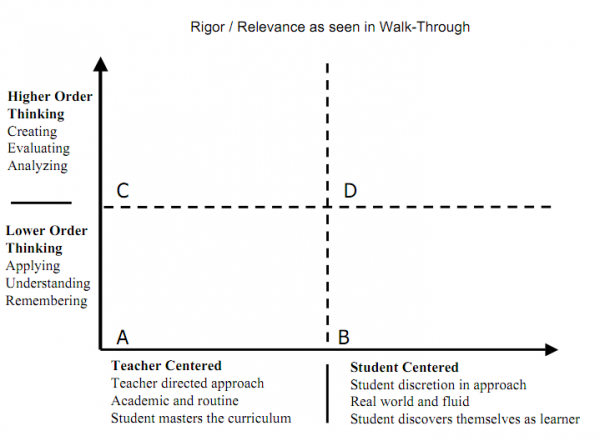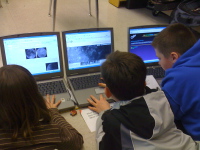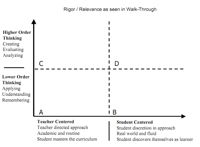I think the most valuable thing I got out of this was to change the perception of my job from "information dispenser to "designer of learning environments." I really enjoyed it. I usually get online to look for jobs in other fields during inservice, but I didn't do that once during your workshop. I am actually exited about using this information.
Teaching American History Grant – The Student as Historian
The best part of the workshop is that we had time to practice and digest the information were were using.
A good "kick in the pants" on some big picture ideas.
Made me revisit my own strategies…. Questioning strategies were repeatedly reinforced.
My head is spinning and I am giddy from all the resources and insights.
I need to reevaluate the way I teach. You gave me a lot to think about.
Got me excited about what I'm going to do next in my classroom.
Principal Academy – Rigor and Relevance Walk-Through Training
The real walkthroughs were beneficial because I was practicing what we discussed in the morning.
This will push me to look for a deeper level of instruction from staff – a deeper level of learning in students.
Just the nudge I needed to "refocus" my professional conversations. I'll be looking at classrooms with a more focused lens.
It makes me want to go back to teaching students – I would be a much better teacher.
K-12 Walk Throughs Foster Teacher Reflection

Rigor and Relevance Walkthrough
I recently conducted walk through training (WT) at Hood River County School District in Oregon. I thought the model we used was very effective at engaging teachers and administrators in reflective discussion on instructional practice.
In February, I did half-day presentations on Rigor, Relevance and Literacy to Hood River’s K-5 and 6-12 faculties. In April, I led teams on WTs to give them on opportunity to hone their observational skills. It’s one thing to talk about rigor and relevance in a workshop. It’s another to go into a classroom and try to decide the level of Bloom’s taxonomy being used by the students.
Observers were not in classrooms to evaluate teachers or instructional strategies, but to test their observational skills and have an opportunity to dialogue about their conclusions. We used this simple form to guide our efforts and keep our focus on observation, reflection and discussion. R-R-guide2.pdf 16kb pdf
One day was devoted to K-12 administrative and TOSAs. The next two days were spent with K-12 teacher teams. Each day we began with an orientation session. The team started doing WT’s at an elementary building, then moved to middle and finally, high school. We only visited teachers who had volunteered to host our team. At each building we met periodically to process what we had seen.
The most powerful element of the day, was the K-12 settings of the WTs and the use of K-12 teacher teams. Teachers seldom see other classes in action and it rare that a high school teacher would be given a chance to observe an elementary class or vice versa. All the participants agreed it was a very valuable experience and they came away with greater respect for the contributions being made all each levels of the program. Most importantly, they became more skillful at assessing the rigor and relevance of a variety of instructional strategies. They were then able to apply those perspectives to their own instructional practice. The district intends to support teachers in collegial observation and peer reflection.
For an updated guide for how to conduct classroom walkthoughs see my post: Teacher-Led Professional Development: Eleven Reasons Why You Should be Using Classroom Walk Throughs
How do I put students in charge of thinking in my classroom?
I spent the month of February in Oregon giving a series of workshops across the state. But I didn’t do all the talking. I had many chances to listen to students, teachers, and administrators in a variety of settings – focus groups, planning sessions and classrooms walk-throughs.
 One question posed by a teacher captured a central challenge to education in the 21st century – “How do I put students in charge of thinking in my classroom?”
One question posed by a teacher captured a central challenge to education in the 21st century – “How do I put students in charge of thinking in my classroom?”
<<< North Bend OR 4th graders investigate the phases of the moon
Accountability is here to stay. There’s no going back to the “bell curve” of academic winners and losers. Life-long learning dictates that children will need to become self-directed learners. But too many teachers feel compelled to rush through course material to cover a multitude of benchmarks and standards. For them, the demands of time and testing, limit their opportunities to teach to greater depth.
My workshops attempt to point a way out of this dilemma. We take the approach that instruction must be organized to help students gradually take responsibility for their learning. We focus on idea that learning is relevant to students when the student:
- Understands how the information or skill has some application in their life.
- Has an opportunity to try their own learning approaches, rather than just learn the facts.
- Is not just learning content and skills, but is learning how they learn.
Teachers need support to make the transition to this style of instruction. Administrators need to reinforce the idea that teaching for greater depth beats teaching to the test. The curricula needs to be compacted to provide more time for students to explore their own approaches. Staff development and curriculum resources need to target more rigorous and relevant instructional models. Teachers should be given opportunities for faculty collegial interaction and classroom walk-throughs to showcase best practices.
These initiatives come with a reciprocal accountability. Administrators support teachers to foster greater rigor and relevance in the classroom. In return, they can expect to see those strategies being utilized when they visit the classroom.
I’m encouraged by the bright students and dedicated educators I met in Oregon – working together to redefine the 21st century classroom. As one teacher commented, “I realize that all children are capable of higher-level thinking. We need to continue teaching kids to think for themselves, teach each other, get involved… their futures depend on it.”

